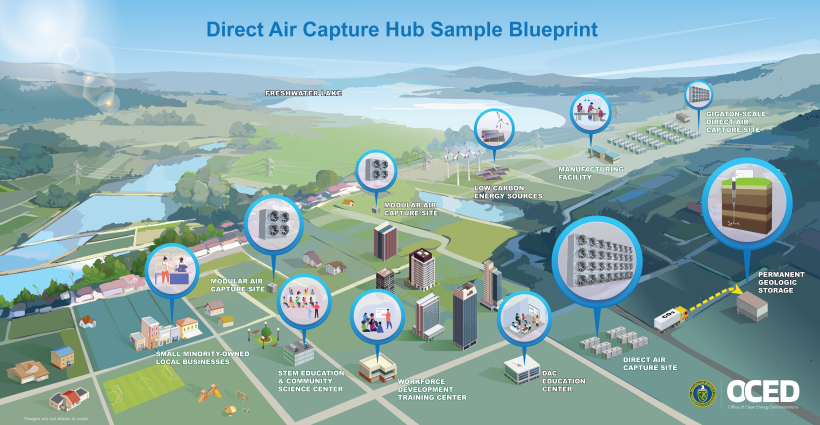This October, DOE’s Office of Clean Energy Demonstrations, in collaboration with the National Energy Technology Laboratories (NETL), announced the four recipients of a total of $3,500,000,000 in funding for their Regional Direct Air Capture Hubs (DAC Hubs) program.
In the months since the announcement, the selected Hubs have been heads down making plans, likely looking to hit the ground running in the new year. If you’re looking to scale up your knowledge to better understand DAC developments as they unfold, this blog explains the goals of DOE’s Carbon Negative Shot and what features judges sought as they evaluated Hub applications.
Let’s dive in! 🐬
The project has three main goals:
Provide proof of concept
Due to the high-tech innovation that DAC entails, some critics remain skeptical of its ability to deliver on the scale needed. The Regional DAC Hubs program seeks to assuage these concerns by demonstrating DAC’s ability to deliver results across all stages of the carbon management supply chain. Extracting the carbon from the atmosphere is just the first step: other important stages include processing, transporting, and either sequestering or utilizing the gas in a way that keeps it out of the atmosphere for at least a millennium. As part of this endeavor, the program seeks to build out the infrastructure needed to scale DAC technologies and the broader carbon management ecosystem: think “clean power generation, heat integration, [carbon] transport, and secure geologic storage and conversion pathways for captured CO2,” says NETL Project Manager Elliot Roth.
Speed technology deployment
To grow at the pace needed to meet our climate goals, DAC must win not only public but also private capital – and the public funding from this DOE program provides the support needed to demonstrate to potential private investors that these DAC technologies, and the broader carbon management ecosystem they inhabit, are ready to scale commercially. Roth says that to build investor confidence, the program will promote “assessing scale-up risks, cost performance, business models, host sites, infrastructure, markets and financing structures for the most promising technologies and Hub approaches.”
Enhance US DAC leadership:
DAC isn’t only the most verifiable of carbon removal technologies; it’s also one of the most technologically-intensive. Although the technology’s cutting-edge nature poses some logistical hurdles, it also presents an enormous opportunity for the US to apply its scientific prowess to lead the charge towards innovation – and to apply its business acumen to scaling the technology at the pace demanded by our climate goals, setting an example for the rest of the world.
Application parameters: What the judges wanted
As part of the Department of Energy’s Carbon Negative Shot, the Office of Clean Energy Demonstrations and the National Energy Technology Laboratories are granting $3.5 billion in funding over four years to support the development of four regional Direct Air Capture (DAC) hubs.
To be eligible for funding, NETL states that projects must demonstrate the potential to:
- Remove 1,000,000 metric tons of CO2 annually, either from individual or from multiple interconnected units
- Sequester 1,000,000 metric tons of CO2 annually, either from individual or from multiple interconnected units
- Contribute to regional or interregional carbon management networks
The Biden Administration’s press release emphasizes that Project Cypress, South Texas DAC Hub, and the additional hubs which DOE will select in future rounds of competition will maximize benefits and minimize harm to host communities. To do so, they must “ensure meaningful community and labor engagement and contribute to the President’s Justice40 Initiative, which set a goal that 40% of the overall benefits of certain federal investments, such as climate and clean energy, go to disadvantaged communities that have been marginalized and overburdened by pollution and underinvestment.” Consequently, at all stages of project development, DOE evaluated contest entrants for their potential for positive community impact.
DAC Hubs Resources
To learn more about the impact of U.S. industrial policy on climate tech generally, Catalyst with Shayle Kann offers a great overview here. And if you’re interested in spreading the word about your organization’s own direct air capture milestones, contact FischTank PR at [email protected] to learn more about our services in media relations, branding, and content development for climate tech firms.



